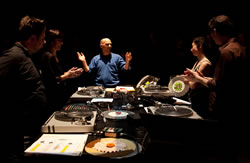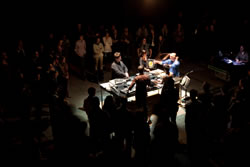[Report]
Martin Tétreault’s Turntable Quartet in Akousma 9
AKOUSMA 2012, 9th edition — Festival of Electroacoustic Music
24–27 October 2012
Montréal, Canada: Usine C
http://www.akousma.ca
Montréal is without a doubt the centre of electroacoustic music in North America, and this is in no small part due to the efforts of Réseaux des arts médiatiques. Founded in 1991, Reseaux’s mission is to:
publicly present [a variety of electroacoustic works] using an array of loudspeakers. The works in question can be acousmatic (tape music), mixed (tape and instruments), live (live electronics) or include other art forms, such as video, dance or installation art. (Akousma website, “About Us”)
The city is truly lucky to enjoy the efforts of a group like Réseaux, let alone one when it is partnered with an institution like the Conservatoire de musique et d’art dramatique du Québec and world-class venues such as Usine C.
In its more than 20 years of existence, Réseaux has presented over 100 international composers to audiences in Montréal. The Akousma festival of electroacoustic music in Montréal, produced by Réseaux, is now in its ninth edition of the annual Fall festival, though they have also presented events in the off-season and at other venues in different cities, such as Troy, New York’s fantastic EMPAC — Experimental Media and Performing Arts Center theatre (which is current home to legendary co-founder of the San Francisco Tape Music Center, Pauline Oliveros, also a past performer at Akousma).
Each night of the festival, which ran this year from October 24–27, began with artist discussions in the café, before two sets in the main hall. Usine C itself was formerly a marmalade factory, but thanks to a multi-million dollar renovation was converted in the late ’70s into one of Montréal’s finest multi-media venues. The festival included performances by Manuela Blackburn, Keith Fullerton Whitman, Francisco López, Daniel Menche and others.

Martin Tetreault’s turntable quartet performed the second set of the opening night of the festival, bringing together various traditions in an innovative way. Electroacoustic music owes no small debt to the musique concrète of Pierre Schaeffer, which primarily developed techniques of manipulating phonographic records, and so in this way Tetreault’s use of the turntable closes the circle.
Pierre Schaeffer described sound technologies as producing acousmatic sounds, sounds that are isolated from their source. While working as a broadcaster during the late 1940s at Radiodiffusion Française, a radio station in Paris, Schaeffer innovated many techniques utilizing turntables, phonographs, and later tape recorders to manipulate pre-recorded sound in order to produce new compositions, an act which was radically innovative at the time. Since that time, many of these early techniques have become standard techniques employed by producers and electroacoustic artists all over the world. These techniques included looping samples, playing them backwards, changing the speed of playback to alter the pitch, and more. Rather than organizing compositions on the basis of traditional principles such as melody, harmony or meter, Schaeffer and his associates relied on timbre, tone and spectrum, using textures and events to produce dynamics and narrative. The resulting compositions existed as recordings, and therefore were very obviously a studio art rather than a performance art in the way we think of “live” music.
The term acousmatic itself originates with the Greek pre-Socratic philosopher Pythagoras, who delivered lectures to his novice students from behind a screen, forcing them to focus on the content of his words rather than on his presence. Just as the Greek logos became the Christian Word of God, acousmatic carries with it an implied and often unchallenged assumption regarding the relationship between a “source” and a “copy.” The Word came to be privileged as more alive compared with the “dead” letters of writing, resulting in a metaphysics of presence that went unchallenged in the Western world until the 20th century. Schaeffer himself was also a devout Catholic, and one might suggest that his relationship with sound, which he described as acousmatic, follows this theological framework.
This narrative hasn’t gone unproblematized. In his now classic work The Audible Past, Jonathan Sterne writes that figures such as Schaeffer:
assume that sound-reproduction technologies can function as neutral conduits, as instruments rather than substantive parts of social relationships, and that sound-reproduction technologies are ontologically separate from a “source” that exists prior to and outside its affiliation with the technology. Attending to differences between “sources” and “copies” diverts our attention from processes to products; technology vanishes, leaving as its by-product a source and a sound that is separated from it. (Sterne 2003, 21)
We can clearly see this at work in much electroacoustic music, perhaps no more so than in the performances of Francisco López, who literally blindfolds the audience and covers his console in a tarp, literalizing the absence, the lack, and using it in favour of his compositions. Other contemporary artists, however, such as Giuseppe Ielasi, seem very much aware that mediation is not a neutral tool that re‑presents a more authentic source but is, one can say, the message itself. His recent LPs of the past four years (the Stunt series, Tools, 15 CDs, 15 Tapes, his Bellows collaborations with Nicola Ratti) list only the media employed itself and not the source material, putting the emphasis on reel-to-reel players, CDJs, effects pedals, a Discman, on the CDs, or tapes, or vinyl records themselves as media. Sterne asserts:
Sound reproduction was a studio art, and, therefore, the source was as bound up in the social relations of the reproducibility as any copy was. On the contrary, sound reproduction — from its very beginnings — always implied social relations among people, machines, practices and sounds…. Sound reproduction is a social process.
The question of “authenticity” or even “fidelity” rather misses the point, or at least diverts attention of the materiality at hand. “Reproduced sounds are not simply mediated versions of unmediated original sounds.” (Sterne 2003, 219)
The Akousma festival presented a variety of work that allowed insight into this line of thought, some improvised and site-specific while others were pre-composed pieces, but all took full advantage of the generous multichannel sound system at Usine C.
In an atypical configuration, Tétreault presented his Turntable Quartet, directing / conducting the four performers (Magali Babin, David Lafrance, Alexander Macsween and Nancy Tobin), who were situated in the centre of the audience, facing each other around a table (Fig. 2). Martin Tétreault is something of a local legend, an internationally praised DJ and improviser, and one of the sure highlights of Quebec’s musique actuelle scene. Trained in the visual arts, he brings a conceptual approach to his work and has a long list of equally impressive collaborators. His recent turntable experiments explore the sounds of the turntable itself, and he directed his quartet that evening utilizing turntables, mixers and prepared discs. This relationship, by its very nature, calls into question a variety of forms one might take for granted. Surrounded by the audience, Tétreault was more than just conductor, but also the composer (as producer). In lieu of a score, Tétreault had prepared various records, some of which were modified with pieces of material to produce regular, rhythmic loops, sounding not at all unlike that of a techno DJ, but probably more akin to the early turntable work of Christian Marclay. The format looks classical in its arrangement, with music stands and the conductor directing the performers (Fig. 1), but many elements also call to mind free improv and with moments reminiscent of club music — fittingly, given the history of turntablism. Tétreault was also responding to the room (as physical, sonic space) and the response of the crowd, its mood and accompaniment with the narrative of the journey of the piece, again not unlike a good DJ, which of course in a literal way he is.

Tétreault conducted as the four players with turntables and mixing boards responded to his cues, conveying with hand gestures or a raised eyebrow and a telling gaze. The output of each of the four performers was projected out of the corresponding corners of the room, giving the performance a quadraphonic spatiality that helped the audience members to follow the mechanics of what was occurring. Some of the records were rigged with geometric intervals or other alterations, so that the turntable could make rhythmic looping beats or be manipulated by other techniques. Each piece had a very different and distinct vibe, and each performer got to improvise and be expressive within the compositional authority of Tétreault. The result was something very unique and dynamic, and the freshness of the group’s playing was a welcome contrast to more aleatoric or glitchy practices of some other types of turntablism.
Tétreault has a good reputation here, and it is indicative of what is unique about Montréal that such a practice could cultivate a thoughtful, attentive public. In some sense, Tétreault’s most recent project is almost high modernist in its abstraction, yet formalized and also communitarian in the sense that the audience’s response is incorporated into its own unfolding. In terms of the parts that make up the whole, there is nothing radically new here: seeing Tétreault conducting, with the musicians configured in a manner that is reminiscent of a string quartet; the turntable being instrumentalized; using prepared objects for sound production / manipulation; incorporating improvisation within a compositional structure. Taken altogether, however, they produced something rather extraordinary.
Bibliography
Sterne, Jonathan. The Audible Past: Cultural Origins of Sound Reproduction. Durham: Duke University Press, 2003.
Social top